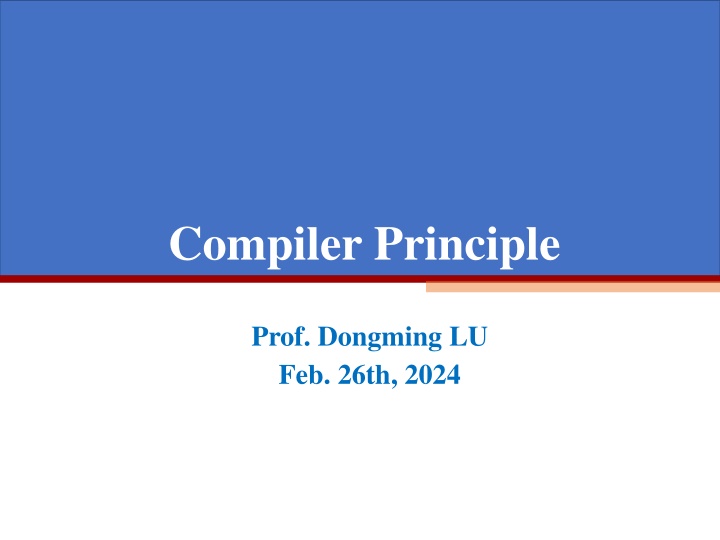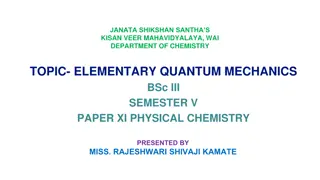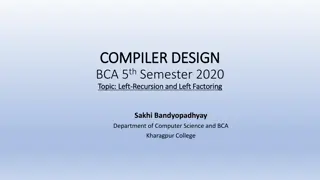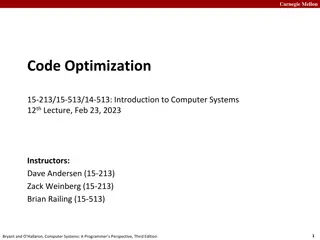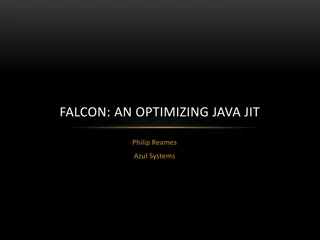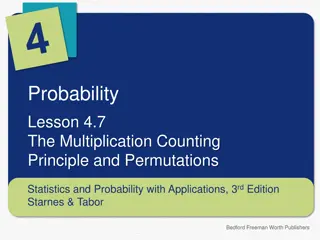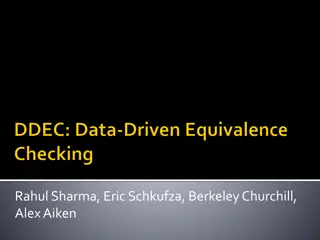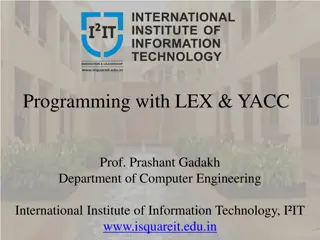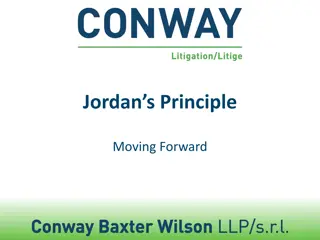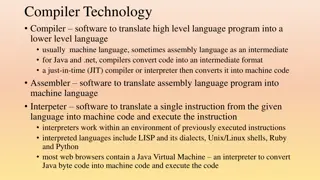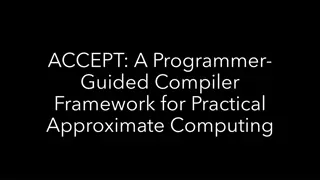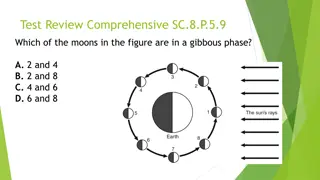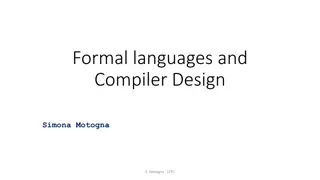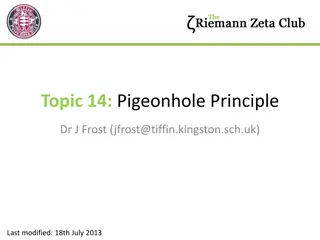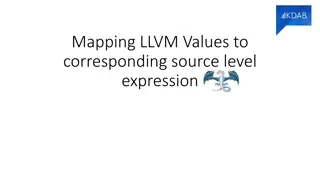Compiler Principle by Prof. Dongming LU: Overview and Phases
Compiler Principle course explores the translation of programming languages into executable code using techniques, data structures, and algorithms. The course covers modules, interfaces, and phases of a typical compiler, emphasizing the importance of abstract syntax and intermediate code. Key concepts include the role of modules, advantages of interfaces, and detailed descriptions of compiler phases such as lexical analysis and parsing. Understand the complexity of compilers and their applications in various computing scenarios.
Download Presentation

Please find below an Image/Link to download the presentation.
The content on the website is provided AS IS for your information and personal use only. It may not be sold, licensed, or shared on other websites without obtaining consent from the author.If you encounter any issues during the download, it is possible that the publisher has removed the file from their server.
You are allowed to download the files provided on this website for personal or commercial use, subject to the condition that they are used lawfully. All files are the property of their respective owners.
The content on the website is provided AS IS for your information and personal use only. It may not be sold, licensed, or shared on other websites without obtaining consent from the author.
E N D
Presentation Transcript
Compiler Principle Prof. Dongming LU Feb. 26th, 2024
Content Content 1. INTRODUCTION 2. 3. 4. 5. LEXICAL ANALYSIS PARSING ABSTRACT SYNTAX SEMANTIC ANALYSIS 6. 7. ACTIVATION RECORD TRANSLATING INTO INTERMEDIATE CODE 8. OTHERS
What is a compiler? A compiler is a program to translates one language to another Source Program Target Program Compiler A compiler is a complex program From 10,000 to 1,000,000 lines of codes Compilers are used in many forms of computing Command interpreters, interface programs
What will be discussed in this course? Describing Techniques Data structures Algorithms for translating programming languages into executable code. A Real program language Tiger: Simple and Nontrivial
Two Important Concepts Phases: one or more modules Operating on the different abstract languages during compiling process Interfaces Describe the information exchanged between modules of the compiler
Modules Role: implementing each phase Advantage: allowing for reuse of the components Changing the target-machine Changing the source language
Interfaces The data structures: Abstract Syntax, IR Trees and Assem. A set of functions: The translate interface A function called by parser: The token interface
Phases Description of compiler phases Chapter Phase Description 2 Lex Break the source file into individual words, or tokens Analyze the phrase structure of the program Build a piece of abstract syntax tree corresponding to each phrase 3 Parse 4 Parsing Actions
Phases Description of compiler phases Chapter Phase Description 5 Semantic Analysis Determine what each phrase means Relate uses of variables to their definitions Check types of expressions Request translation of each phrase Place variables, function-parameters, etc. into activation records (stack frames) in a machine-dependent way. Produce intermediate representation trees (IR trees) Not tied to any particular source language or target-machine architecture. 6 Frame Layout 7 Translate
Phases Description of compiler phases Chapter Phase Description 8 Canonicalize Hoist side effects out of expressions Clean up conditional branches for the convenience of the next phases. Group the IR-tree nodes into clumps that correspond to the actions of target-machine instructions. Analyze the sequence of instructions into a control flow graph that shows all the possible flows of control the program might follow when it executes. 9 Instruction Selection 10 Control Flow Analysis
Phases Description of compiler phases Chapter Phase Description 10 Dataflow Analysis information through variables of the program For example, liveness analysis calculates the places where each program variable holds a still-needed value (is live) 11 Register Allocation and temporary values used by the program; variables not live at the same time can share the same register 12 Code Emission instruction with machine registers Gather information about the flow of Choose a register to hold each of the variables Replace the temporary names in each machine
Modularization Several modules maybe combined into one phase: Parse, Semantic Analysis, Translate, Canonicalize Instruction Selection maybe combined with Code Emission Simple compilers may omit the Control Flow Analysis, Data Flow Analysis, and Register Allocation phases
Two of the most useful abstractions (1) Context-Free Grammars for parsing (2) Regular Expressions for lexical analysis.
Two tools for compiling (1) Yacc converts a grammar into a parsing program (2) Lex converts a declarative specification into a lexical analysis program The programming project in the book can be compiled using any ANSI-standard C compiler, along with Lex and Yacc.
1.3 Data structures for tree languages
Intermediate Representations (IR) The form of a compiling program Trees Representation(TR) The main representation forms Several node types with different attributes TR: described with grammars like programming languages Introduce the concepts with a simple programming language
Syntax for a simple language Stm Stm; Stm Stm id := Exp Stm print (ExpList) Exp id Exp num Exp Exp Binop Exp Exp (Stm, Exp) ExpList Exp, ExpList ExpList Exp Binop + Binop Binop Binop / (CompoundStm) (AssignStm) (PrintStm) (IdExp) (NumExp) (OpExp) (EseqExp) (PairExpList) (LastExpList) Node types (Plus) (Minus) (Times) (Div) GRAMMAR 1.3: A straight-line programming language.
Informal semantics of the language Stm Exp is a statement is an expression. s1; s2 executes statement s1, then statement s2 i :=e evaluates the expression e, then "stores" the result in variable i. print(e1, e2, , en) displays the values of all the expressions, evaluated left to right, separated by spaces, terminated by a newline. Id yields the current contents of the variable i number evaluates to the named integer operator expression e1 op e2 evaluates e1, then e2, then applies the given binary operator expression sequence (s, e) like the C-language "comma" operator, evaluating the statement s for side effects before evaluating the expression e.
An example of a program Executing the following program a := 5+3; b := (print(a, a-1), 10*a); print(b) prints 8 7 80
Tree data structure definiton Each grammar symbol can corresponds to a typedef in the data structures: Grammar Typedef Stm Exp ExpList id num A-stm A-exp A-expList string int
Data structure definition for this simple language Typedef char *string; Typedef struct A_stm_ *A_stm; Typedef struct A_exp_ *A_exp; Typedef struct A_expList_ *A_expList Typedef enum {A_plus, A_Minus, A_times, A_div} A_binop Struct A_stm_ { enum {A_compoundStm, A_assignStm, A_printStm} Kind union { struct {A_stm stm1, stm2;} compound; struct {string id; A_exp exp;} assign; struct {A_expList exps;} print; } u; } A_stm A_CompoundStm(A_stm stm1, A_stm stm2); A_stm A_AssignStm(string id, A_exp exp;} A_stm A_PrintStm(A_expList exps);
Syntax for a simple language Stm Stm; Stm Stm id := Exp Stm print (ExpList) Exp id Exp num Exp Exp Binop Exp Exp (Stm, Exp) ExpList Exp, ExpList ExpList Exp Binop + Binop Binop Binop / (CompoundStm) (AssignStm) (PrintStm) constructor names (IdExp) (NumExp) (OpExp) (EseqExp) (PairExpList) (LastExpList) (Plus) (Minus) (Times) (Div) GRAMMAR 1.3: A straight-line programming language.
One constructor for each grammar rule The constructor names: indicated on the right-hand side of G { The CompoundStm has two Stm's on the right- hand side; Stm Stm; Stm The AssignStm has an identifier and an expression; Stm id := Exp } Right-hand-side components: represented in the data structures Struct of each grammar symbol A union to carry these values A kind field to indicate which variant of the union is valid
One constructor for each grammar rule A constructor function: Malloc and initialize the data structure Such as CompoundStm, AssignStm, etc A-stm A_CompoundStm(A_stm stm1, A_stm stm2){ A_stm s = checked_malloc(sizeof(*s)); s->kind = A_compoundStm; s->u.compound.stm1=stm1; s->u.compound.stm2=stm2; return s; }
One constructor for each grammar rule Binop will be simpler. Binop + Binop Binop Binop / Making a Binop struct - with union variants for Plus, Minus, Times, Div will be overkill None of the variants would carry any data. Instead, making an enum type A_binop.
Programming style Several conventions for representing tree data structures in C 1. Trees are described by a grammar. 2. A tree is described by one or more typedef, each corresponding to a symbol in the grammar. 3. Each typedef defines a pointer to a corresponding struct. The struct name, which ends in an underscore, is never used anywhere except in the declaration of the typedef and the definition of the struct itself.
Programming style 4. Each struct contains a kind fields An enum showing different variants, one of each grammar rule; and a u field, which is a union. 5. There is more than one nontrivial(value-carraying) symbol in the right-hand side of a rule (example: the rule CompoundStm), The union has a component that is itself a struct comprising these values (example: the compound element of the A_stm union).
Programming style 6. There is only one nontrivial symbol in the right-hand side of a rule, The union will have a component that is the value (example: the num field of the A_exp union) 7. Every class will have a constructor function that initializes all the fields. The malloc function shall never be called directly, except in these constructor functions.
Programming style 8. Each module (head file) shall have a prefix unique to that module (example, A_ in Program 1.5) 9. Typedef names(after the prefix) shall start with lowercase letters; constructor functions(after the prefix ) with uppercase; enumeration atoms(after the prefix) with lowercase; and union variants(which have no prefix) with lowercase. A-stm A_CompoundStm(A_stm stm1, A_stm stm2){ A_stm s = checked_malloc(sizeof(*s)); s->kind = A_compoundStm; s->u.compound.stm1=stm1; s->u.compound.stm2=stm2; return s; }
Modularity principle for C programs Careful attention to modules and interfaces prevents chaos in a compiler program 1. Each phase or module of the compiler belongs in its own .c file, with a corresponding .h file. 2. Each module shall have a prefix unique to that module. All global names exported by the module shall start with the prefix 3. All functions shall have prototype The C compiler shall be told to warn about uses of functions without prototypes
Modularity principle for C programs 4. The inclusion of assert.h encourages the liberal use of assertion by the C programmer 5. The string type means a heap-allocated string that will not be modified after its initial creation. 6. C s malloc function returns NULL if there is no memory left. 7. We will never call free.
